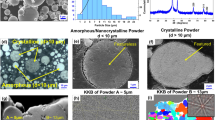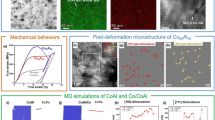Abstract
In this paper, details are given for the structural evolution of (Ti33Zr33Hf33)70(Ni50Cu50)20Al10, (Ti25Zr25Hf25Nb25)70(Ni50Cu50)20Al10, and (Ti33Zr33Hf33)70(Ni33Cu33Ag33)20Al10 amorphous alloys, part of wider program of alloy development by equiatomic substitution. All three alloys initially crystallize by forming a nanoscale icosahedral phase. However, at higher temperatures, their decomposition sequences differ significantly. The nanoscale icosahedral phase in the (Ti33Zr33Hf33)70(Ni50Cu50)20Al10 alloy decomposes into a mixture of Zr2Cu-type and icosahedral phases. This icosahedral phase still exists after heating up to 970 K, indicating a high thermal stability of this phase. The nanoscale icosahedral phase in the (Ti33Zr33Hf33)70(Ni33Cu33Ag33)20Al10 alloy also transforms into a mixture of Zr2Cu-type and icosahedral phase during the second exothermic reaction but then transforms into a mixture of Zr2Cu-type and Ti2Ni-type phases. The nanoscale icosahedral phase in the (Ti25Zr25Hf25Nb25)70(Ni50Cu50)20Al10 alloy decomposes into a mixture of Ti2Ni-type and MgZn2-type phases during the second exothermic reaction. It is concluded that the formation of the Zr2Cu-type phase retards the decomposition of the nanoscale icosahedral phase, which increases the thermal stability. In contrast, formation of Ti2Ni-type and MgZn2-type phases accelerates the decomposition of the nanoscale icosahedral phase, which decreases its thermal stability.
Similar content being viewed by others
References
A. Inoue, T. Zhang, J. Saida, M. Matsushita, M.W. Chen, T. Sakurai: Formation of icosahedral quasicrystalline phase in Zr–Al–Ni–Cu–M (M=Ag, Pd, Au or Pt) systems. Mater. Trans. JIM 40, 1181 (1999).
A. Inoue, J. Saida, M. Matsushita, T. Sakurai: Formation of an icosahedral quasicrystalline phase in Zr65Al7.5Ni10M17.5 (M = Pd, Au or Pt) alloys. Mater. Trans. JIM 41, 362 (2000).
A. Inoue, T. Zhang, M.W. Chen, T. Sakurai, J. Saida, M. Matsushita: Ductile quasicrystalline alloys. Appl. Phys. Lett. 76, 967 (2000).
J. Saida, M. Matsushita, C. Li, A. Inoue: Formation of icosahedral quasicrystalline phase in Zr70Ni10M20(M = Pd, Au, Pt) ternary metallic glasses. Appl. Phys. Lett. 76, 3558 (2000).
L.Q. Xing, J. Eckert, W. Löser, L. Schultz: High-strength materials produced by precipitation of icosahedral quasicrystals in bulk Zr–Ti–Cu–Ni–Al amorphous alloys. Apply. Phys. Lett. 74, 664 (1999).
S. Scudino, U. Kühn, L. Schultz, H. Breitzke, K. Lüders, J. Eckert: Formation of quasicrystals in ball-milled amorphous Zr–Ti–Nb–Cu–Ni–Al alloys with different Nb content. J. Mater. Sci. 39, 5483 (2004).
J. Saida, M. Matsushita, A. Inoue: Precipitation of an icosahedral quasicrystal phase in Zr70Pd20Ni10 amorphous alloy. Mater. Trans. JIM 41, 543 (2000).
B. Cantor, K.B. Kim, P.J. Warren: Novel multicomponent amorphous alloys. Mater. Sci. Forum 386–388, 27 (2002).
K.B. Kim, P.J. Warren, B. Cantor: Metallic glass formation in multicomponent (Ti,Zr,Hf,Nb)–(Ni,Cu,Ag)–Al alloys. J. Non-Cryst. Solids 317, 17 (2003).
K.B. Kim, P.J. Warren, B. Cantor: Formation of metallic glasses in novel (Ti33Zr33Hf33)100-x-y (Ni50Cu50)x Aly alloys. Mater. Trans. JIM 44, 411 (2003).
K.B. Kim, Y. Zhang, P.J. Warren, B. Cantor: Crystallisation behaviour in a new multicomponent Ti16.6Zr16.6Hf16.6Ni20Cu20Al10 metallic glass developed by the equiatomic substitution technique. Philos. Mag. 83, 2371 (2003).
L.C. Zhang, J. Xu: Glass-forming ability of melt-spun multicomponent (Ti, Zr, Hf)–(Cu, Ni, Co)–Al alloys with equiatomic substitution. J. Non-Cryst. Solids 347, 166 (2004).
L.C. Zhang, Z.Q. Shen, J. Xu: Glass formation in a (Ti,Zr,Hf)–(Cu,Ni,Ag)–Al high-order alloy system by mechanical alloying. J. Mater. Res. 18, 2141 (2003).
K.B. Kim, P.J. Warren, B. Cantor: Glass forming ability and crystallization behaviour of new multicomponent (Ti33Zr33Hf33)60(Ni50Cu50)20Al20 alloy developed by equiatomic substitution. J. Metastable Nanocryst. Mater. 15–16, 143 (2003).
K.B. Kim, P.J. Warren, B. Cantor: Glass forming ability of novel multicomponent (Ti33Zr33Hf33)–(Ni50Cu50)–Al alloys developed by equiatomic substitution. Mater. Sci. Eng. A 375–377, 317 (2004).
Y.C. Kim, J.M. Park, J.K. Lee, W.T. Kim, D.H. Kim: Precipitation of stable icosahedral phase in Ti-based amorphous alloys. Mater. Trans. JIM 44, 1978 (2003).
P.A. Bancel, P.A. Heiney: Icosahedral aluminum-transition-metal alloys. Phys. Rev. B 33, 7917 (1986).
L.Q. Xing, Y.T. Shen, K.F. Kelton: Precipitation of an icosahedrally symmetric ordered phase in Zr–Ti–Cu–Ni–Al metallic glasses. Appl. Phys. Lett. 81, 3371 (2002).
K.F. Kelton: Ti/Zr/Hf-based quasicrystals. Mater. Sci. Eng. A 375–377, 31 (2004).
M.W. Chen, T. Zhang, A. Inoue, A. Sakai, T. Sakurai: Quasicrystals in a partially devitrified Zr65Al7.5Ni10Cu12.5Ag5 bulk metallic glass. Appl. Phys. Lett. 75, 1697 (1999).
J.K. Lee, G. Choi, D.H. Kim, W.T. Kim: Formation of icosahedral phase from amorphous Zr65Al7.5Cu12.5Ni10Ag5 alloys. Appl. Phys. Lett. 77, 978 (2000).
D. Turnbull: Under what conditions can a glass be formed. Contemp. Phys. 10, 473 (1969).
Z.P. Lu, C.T. Liu: A new glass-forming ability criterion for bulk metallic glasses. Acta Mater. 50, 3501 (2002).
W.J. Kim, K.F. Kelton: Icosahedral-phase formation and stability in Ti–Zr–Co alloys. Philos. Mag. Lett. 74, 439 (1996).
E.H. Majzoub, R.G. Hennig, K.F. Kelton: Rietveld refinement and ab initio calculations of a C14-like Laves phase in Ti–Zr–Ni. Philos. Mag. Lett. 83, 65 (2003).
Author information
Authors and Affiliations
Corresponding author
Additional information
This author was an editor of this journal during the review and decision stage. For the JMR policy on review and publication of manuscripts authored by editors, please refer to http://www.mrs.org/publications/jmr/policy.html.
Rights and permissions
About this article
Cite this article
Kim, K.B., Warren, P.J., Cantor, B. et al. Enhanced thermal stability of the devitrified nanoscale icosahedral phase in novel multicomponent amorphous alloys. Journal of Materials Research 21, 823–831 (2006). https://doi.org/10.1557/jmr.2006.0103
Received:
Accepted:
Published:
Issue Date:
DOI: https://doi.org/10.1557/jmr.2006.0103




